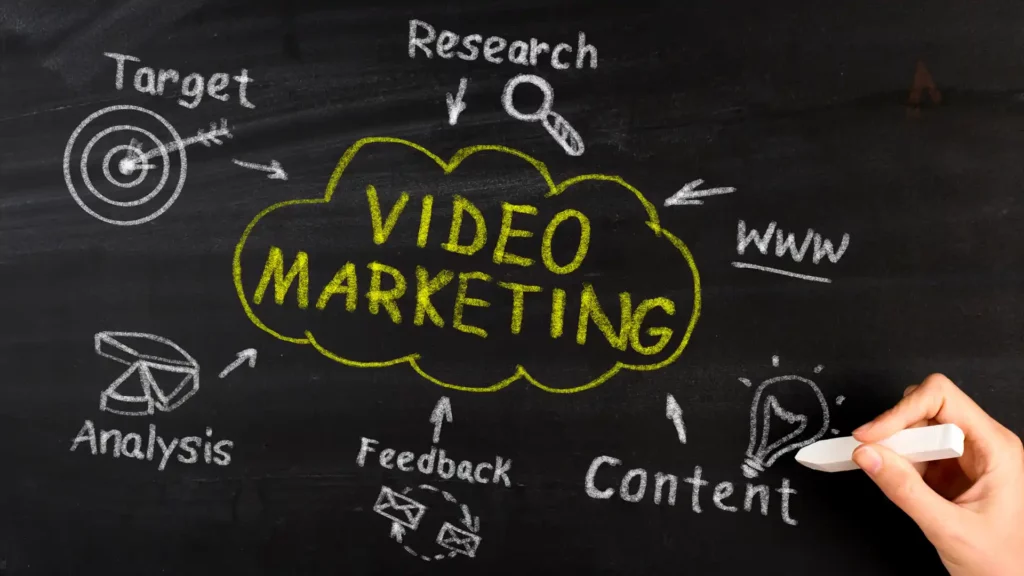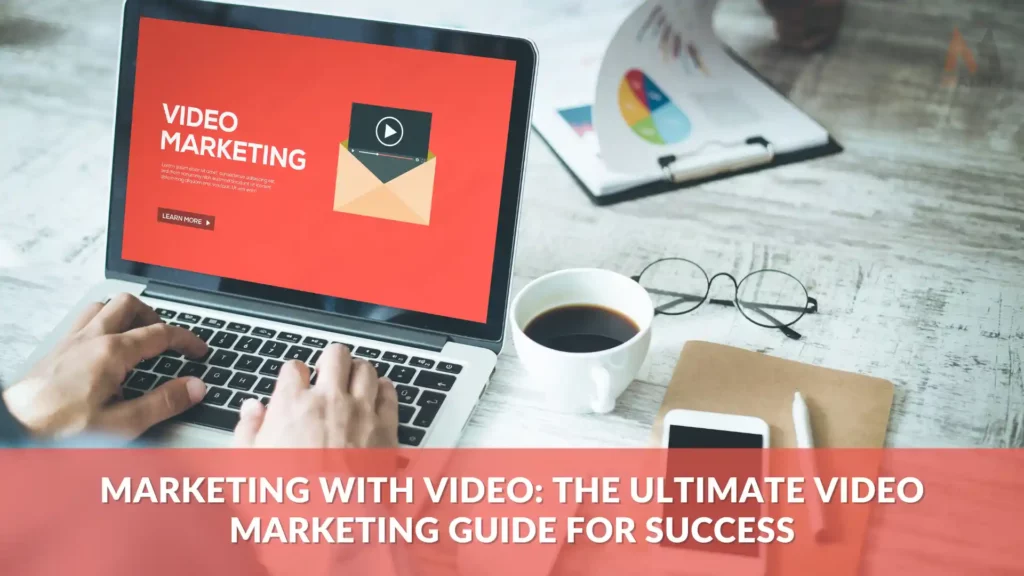Marketing with Video: The Ultimate Video Marketing Guide for Success
Learn About Marketing with Video: The Ultimate Video Marketing Guide for Success
John has been the Chief Marketing Officer at SaaSX Corp for five years, always looking for new ways to increase website traffic. When he noticed that their competitors were getting more visits than they were, he knew something needed to be done.
He contacted Matrix Marketing Group, a leading AI digital marketing company with expertise in search engine optimization (SEO). After running an SEO audit of their competitors’ websites, it quickly became apparent why their sites received more traffic – video marketing!

The team at Matrix convinced John that video marketing would be the most effective way for SaaSX to gain visibility online and reach potential customers. John took a leap of faith and invested in creating high-quality videos showcasing SaaSX’s products and services.
Within weeks of launching the campaign, John could see the results – site visitors increased by 25% compared to before! He was also thrilled when some large companies began noticing what SaaSX had accomplished and inquired about working together on future projects. In no time, word spread across social media platforms about how successful SaaSX video campaigns had been– resulting in even more leads!
John thanked his lucky stars for listening to Matrix Marketing Group’s advice; if not, they may have never seen such success from video marketing…let’s see how it was done.
What Is Video Marketing?

Video marketing is a strategic approach to promoting, branding, and engaging with an audience through videos.
It involves creating, publishing, and distributing video content on various platforms such as social media, websites, email campaigns, and more, primarily aiming to increase brand awareness, generate leads, drive sales, or improve customer engagement.
Video marketing can come in many forms, including but not limited to
- Product demonstrations: Showcasing a product’s or service’s features and benefits.
- Tutorials and how-to videos: Educating the audience on a specific topic, skill, or process.
- Testimonials and case studies: Featuring satisfied customers or successful projects to build trust and credibility.
- Behind-the-scenes content: Providing a glimpse into the company’s culture, values, and operations.
- Webinars and live events: Host online presentations, workshops, or discussions for a targeted audience.
- Animated explainer videos: Using animation to simplify complex ideas or concepts.
- Video ads: Creating short promotional clips to drive awareness and conversions.
Successful video marketing requires planning, creativity, and an understanding of the target audience, their preferences, and the platforms on which they engage.
It’s essential to produce high-quality, engaging, and relevant content that effectively communicates the intended message and resonates with viewers.
What Are The Advantages Of Video Marketing

Video marketing offers numerous advantages for businesses and organizations seeking to engage their target audience, increase brand awareness, and drive results. Some key benefits of video marketing include
- Improved engagement: Videos are more engaging than text or images alone, as they appeal to multiple senses and can convey emotion, tone, and visual cues that capture the viewer’s attention.
- Increased retention: People remember visual content better than text-based content. Videos can leave a lasting impression and help convey complex messages more effectively.
- Enhanced trust and credibility: Featuring real people, testimonials, or case studies in videos can help build trust and credibility with potential customers, making them more likely to purchase or engage with the brand.
- Better conversion rates: Videos can help guide viewers through the buying process and demonstrate the value of a product or service, ultimately leading to higher conversion rates.
- Greater reach and shareability: Video content is easily shareable across various platforms, such as social media, websites, and email campaigns, extending the reach of marketing efforts and potentially going viral.
- Improved SEO: Search engines value high-quality, engaging content, and videos can improve a website’s search engine ranking, making it more visible to potential customers.
- Stronger emotional connections: Videos can evoke emotions and create a more profound connection with the audience, increasing the likelihood of them taking action or remembering the brand.
- Easy accessibility: With the ubiquity of smartphones and high-speed internet, people can consume video content anytime, anywhere, making it an accessible and convenient form of communication.
- Versatility: Videos can be used in various formats and across multiple platforms, allowing businesses to repurpose content and tailor it to their marketing objectives.
- Measurable results: Video marketing provides trackable metrics, such as views, watch time, and engagement, allowing businesses to analyze the effectiveness of their campaigns and make data-driven decisions.
Video marketing offers numerous advantages for businesses and organizations, making it an essential component of any comprehensive marketing strategy.
Video marketing is best used in these industries.

Video marketing can be highly effective in various industries, providing a versatile and engaging way to communicate with target audiences.
Some industries where video marketing has proven to be particularly successful include
- E-commerce and retail: Product demonstrations, unboxing videos, and promotional offers can drive sales and showcase the features and benefits of products.
- Software and technology: Explainer videos and tutorials can help clarify complex concepts, demonstrate software functionality, and highlight unique selling points.
- Education and e-learning: Online courses, educational content, and training materials can be delivered through video to facilitate learning and engagement.
- Travel and tourism: Travelogs, destination highlights, and virtual tours can inspire potential travelers and showcase the experiences a location or tour operator offers.
- Food and beverage: Recipe videos, cooking demonstrations, and behind-the-scenes content can promote restaurants, food products, or culinary services.
- Health and wellness: Exercise tutorials, product demonstrations, and expert advice can promote health and fitness products or services, such as gyms, supplements, or wellness programs.
- Real estate: Virtual property tours, neighborhood highlights, and agent profiles can help showcase properties and attract potential buyers.
- Entertainment: Movie trailers, music videos, and behind-the-scenes content can generate excitement and anticipation for upcoming releases.
- Non-profit and social causes: Video storytelling can evoke emotions, raise awareness, and encourage support for various causes and organizations.
While video marketing can be advantageous in these industries, it’s essential to note that virtually any industry can benefit from incorporating video into its marketing strategy.
The key is to create high-quality, engaging, and relevant content that resonates with the target audience and aligns with the company’s brand and objectives.
What Are The 7 Steps To Create The Ultimate Video Marketing Campaign

Creating an effective video marketing campaign involves careful planning and execution.
Here are seven steps to help you create the ultimate video marketing campaign:
- Define your objectives: Begin by setting clear, measurable goals for your campaign. These objectives might include increasing brand awareness, generating leads, driving sales, or improving customer engagement. Make sure your goals align with your overall marketing and business strategies.
- Identify your target audience: Understand who your target audience is, what their preferences are, and where they engage online. Research their demographics, interests, and pain points to create content that resonates with them.
- Develop your message and storyboard: Craft a compelling message that addresses the needs and desires of your target audience. Create a storyboard or script that outlines your video’s structure, including scenes, dialogue, and visuals. This will help guide the production process and ensure consistency in your message.
- Choose the right video format: Select the video format that best suits your objectives and target audience. This might include explainer videos, tutorials, testimonials, or product demonstrations. Consider how the format will be consumed across different platforms and devices.
- Produce high-quality content: Invest time and resources in producing high-quality video content. This includes selecting the right equipment, setting up proper lighting and sound, and hiring experienced videographers or animators if necessary. Ensure your content is visually appealing, engaging and effectively communicates your message.
- Optimize for SEO and distribution: Optimize your video content for search engines by including relevant keywords in the title, description, and tags. Create attention-grabbing thumbnails and write compelling video descriptions to encourage clicks and views. To reach a broader audience, distribute your content across multiple platforms, such as social media, websites, and email campaigns.
- Measure and analyze results: Track the performance of your video marketing campaign using various metrics, such as views, watch time, engagement, and conversions. Analyze these results to understand what’s working and what could be improved. Use this data to refine your approach and make data-driven decisions for future campaigns.
Following these steps, you can create a successful video marketing campaign that engages your audience, communicates your message effectively, and achieves your marketing objectives.
What Are The Step To Product A Great Explainer Video For Your Company

Producing a great explainer video for technology requires careful planning and execution to ensure it effectively communicates complex concepts simply and engagingly.
Here are the steps to create an outstanding technology explainer video:
- Identify your target audience: Understand who your viewers are and tailor the content to their needs, preferences, and level of technical knowledge. This will help you create a video that resonates with them and addresses their pain points.
- Define your objectives: Determine the purpose of your explainer video. This could be to educate potential customers about your technology, explain its benefits, or demonstrate how it works. Set clear, measurable goals that align with your overall marketing strategy.
- Craft a clear and concise message: Develop a message that communicates your technology’s key features and benefits in a simple and easy-to-understand manner. Avoid using jargon or complex language that might confuse your audience.
- Write a compelling script: Create a script that outlines the flow of your explainer video, from the introduction to the conclusion. Ensure the script is concise, engaging, and covers all essential points you want to communicate.
- Develop a storyboard: Create a visual representation of your script using a storyboard. This helps you plan the video’s visuals, transitions, and pacing, ensuring a smooth flow and logical progression of ideas.
- Choose an appropriate style: Select a video style that best suits your technology and target audience. This could include animation, live-action, or a combination of both. Animated explainer videos often work well for technology-related topics, as they can simplify complex concepts using visuals and motion graphics.
- Hire a professional team or use a DIY tool: Depending on your budget and skills, hire a professional video production team or use a do-it-yourself (DIY) video creation tool. A professional team will ensure high-quality products, while a DIY tool can be more cost-effective.
- Incorporate visuals and audio: Combine visuals, such as animations, graphics, or live-action footage, with appropriate audio elements, such as voiceover, music, and sound effects. Ensure these elements complement each other and enhance your message.
- Keep it short and engaging: Aim for a video length of around 60-90 seconds, as shorter videos tend to have higher viewer retention. Focus on the most critical aspects of your technology, and avoid overloading the audience with information.
- Edit and refine: Edit your video to ensure it flows smoothly, has a consistent pace, and effectively communicates your message. Make any necessary adjustments and refinements before finalizing the video.
- Optimize for distribution: Optimize your video for SEO by including relevant keywords in the title, description, and tags. Make it easily shareable on various platforms and devices to reach a broader audience.
- Measure success and iterate: Track the performance of your explainer video using metrics like views, engagement, and conversions. Analyze the results and use this data to make improvements for future videos.
Following these steps, you can create a compelling and informative technology explainer video that effectively communicates your message and engages your target audience.
How Does Video Marketing Help SEO
Video marketing can positively impact SEO in several ways, as search engines like Google increasingly value high-quality, engaging content. Integrating video content into your marketing strategy can help boost your SEO efforts in the following ways:
- Increased user engagement: Videos tend to capture users’ attention more effectively than text or images alone, leading to longer page visits and reduced bounce rates. Search engines consider these factors when ranking websites, and a lower bounce rate with higher engagement can improve your website’s search engine ranking.
- Enhanced dwell time: Dwell time is the amount of time a user spends on a web page after clicking on it from a search result. Longer dwell times signal to search engines that the content is relevant and valuable, which can result in better rankings.
- Quality backlinks: If your video content is valuable, informative, and engaging, other websites may link to it, generating high-quality backlinks. Search engines consider backlinks an essential factor in determining a website’s authority and trustworthiness, leading to better rankings.
- Increased social signals: Videos are more likely to be shared on social media platforms, which can drive traffic to your website and increase social signals. While the direct impact of social signals on SEO is debatable, they can still contribute to improved visibility and increased traffic.
- Rich snippets and video previews: Adding video markup to your website enables search engines to display rich snippets with video previews in search results. This can improve click-through rates, as users are more likely to click on a result with a video preview, leading to more organic traffic.
- Better content diversity: Search engines value websites that offer diverse and engaging content to users. By incorporating video content into your website, you can cater to different user preferences and enhance the overall user experience.
- Enhanced keyword targeting: Video content allows you to target a wider range of keywords by including them in your video titles, descriptions, and transcripts. This can help your website rank for more search terms and drive additional organic traffic.
To maximize the SEO benefits of video marketing, it’s crucial to optimize your video content with relevant keywords, create high-quality and engaging videos, and ensure that your website is easily navigable and accessible to both users and search engines.
You can effectively leverage video marketing to boost your SEO performance and improve your website’s search engine rankings.
How Does Video Marketing Generate Quality Sales Leads?
Video marketing generates quality sales leads by engaging potential customers with visually appealing and informative content.
Video content can build trust and credibility with your target audience by showcasing product features, sharing customer testimonials, or offering valuable insights. As a result, viewers are more likely to be interested in your products or services, leading to higher conversion rates and better-qualified leads.
What types of video content are most effective for generating sales leads?
Different types of video content can effectively generate sales leads depending on your target audience and marketing objectives.
Some of the most effective formats include:
- Product demonstrations: Showcasing the features and benefits of your product or service.
- Tutorials and how-to videos: Educate viewers on using your product or service to solve their problems.
- Testimonials and case studies: To build trust and credibility, share success stories and customer experiences.
- Webinars and live events: Hosting online presentations or workshops to educate and engage with your target audience.
How Can I Optimize My Video Content For Lead Generation?

To optimize your video content for lead generation, consider implementing the following strategies:
- Include strong call-to-actions (CTAs): Encourage viewers to take action, such as visiting your website, signing up for a newsletter, or contacting your sales team.
- Use gated content: Require viewers to provide contact information to access valuable video content, such as webinars or in-depth tutorials.
- Optimize video metadata: Use relevant keywords in your video titles, descriptions, and tags to improve search engine visibility and attract more viewers.
- Integrate lead capture forms: Embed lead capture forms within your video or on the landing page hosting your video to collect potential customer information.
- Track and analyze viewer data: Use analytics tools to monitor video performance and user engagement to refine your content and targeting strategies.
How can I measure the effectiveness of my video marketing efforts in generating sales leads?
To measure the effectiveness of your video marketing efforts in generating sales leads, track key performance metrics, such as:
- Views and watch time: Measure the number of views and the amount of time viewers spend watching your video content.
- conversion rates: Monitor the percentage of viewers who take the desired action, such as submitting a lead form or making a purchase.
- Lead quality: Assess the quality of the leads generated through your video marketing efforts by evaluating factors like lead source, engagement level, and likelihood to convert.
- Return on investment (ROI): Calculate the ROI of your video marketing efforts by comparing the cost of producing and promoting your videos with the revenue generated from the leads they generate.
By monitoring these metrics, you can evaluate the success of your video marketing efforts and make data-driven decisions to improve your lead generation strategies.
What Is The Top AI Marketing Tools To Increase Productivity And Sales
AI-driven marketing tools are transforming how businesses approach marketing, helping them increase productivity, efficiency, and effectiveness. Here are some of the top AI marketing tools available:
- Marketo: A popular marketing automation platform that uses AI-powered predictive analytics to help businesses create personalized marketing campaigns and improve lead scoring.
- HubSpot AI+: A comprehensive inbound marketing, sales, and customer service platform with AI-driven features, such as chatbots, lead scoring, and content recommendations.
- Salesforce Einstein: A set of AI-powered features integrated into the Salesforce CRM platform, helping businesses optimize their sales, marketing, and customer service processes through predictive analytics and automation.
- IBM Watson Marketing: This AI-driven marketing suite offers a range of tools for campaign automation, customer behavior analysis, content personalization, and real-time marketing insights.
- Drift: An AI-powered conversational marketing platform that enables businesses to create chatbots for their websites, helping them engage visitors, qualify leads, and schedule meetings with sales teams.
- Optimizely: A platform that utilizes AI and machine learning for website and app optimization through A/B testing, personalization, and targeting to improve user experience and drive conversions.
- Phrasee: An AI-driven copywriting tool that generates and optimizes marketing language for email, social media, and other digital channels, helping businesses improve engagement and conversions.
- Adobe Sensei: Adobe’s AI technology powers various features across their Creative Cloud, Experience Cloud, and Document Cloud products, including smart image and video editing, personalized content recommendations, and advanced analytics.
- Acquisio: A platform that leverages AI and machine learning to optimize search, social, and display advertising campaigns, helping businesses maximize their ad spend and improve ROI.
- Crayon: An AI-driven market and competitive intelligence tool that tracks and analyzes competitor activity across various channels, providing insights to help businesses refine their marketing strategies.
These AI marketing tools offer a range of capabilities to help businesses streamline their marketing efforts, make data-driven decisions, and improve overall productivity. By integrating these tools into your marketing strategy, you can stay ahead of the competition and achieve better results.
When planning a video marketing campaign, targeting the right keywords is crucial to reach your desired audience and improve visibility on search engines. You can see types of video marketing from the list below.
Here’s a list of potential keywords related to video marketing (we saved you a little time):
- Video marketing
- Video advertising
- Video promotion
- Video content marketing
- Video marketing strategy
- Video marketing tips
- Video marketing ideas
- Video marketing services
- Video marketing tools
- Video marketing platforms
- Social media video marketing
- YouTube marketing
- Video SEO
- Video marketing agency
- Animated video marketing
Keep in mind that the most effective keywords for your campaign will depend on your specific industry, target audience, and marketing objectives.
Conducting thorough keyword research and continuously monitoring and adjusting your keyword strategy to optimize your video marketing efforts is essential.
Video Marketing Examples and Marketing with Video
The best video marketing examples showcase creativity, effective storytelling, and clear messaging to create memorable experiences for viewers. These programs show you why video marketing is so powerful.
Here are some standout examples of successful video marketing campaigns:
- Dollar Shave Club: Their viral video, “Our Blades Are F***ing Great,” humorously introduced the brand’s subscription service while demonstrating their unique selling proposition. The quirky video quickly garnered millions of views and helped propel the company to success.
- Blendtec: The “Will It Blend?” series demonstrates the power and durability of Blendtec blenders by blending various unusual items, such as smartphones and golf balls. These entertaining and engaging videos turned the company into a household name and significantly boosted sales.
- Airbnb: Their “Wall and Chain” video tells a heartfelt story of a former East German border guard who reunites with his family in a Berlin Airbnb apartment. The emotional narrative effectively conveys Airbnb’s brand values and the impact of their services on people’s lives.
- Volvo Trucks: The “Epic Split” video, featuring Jean-Claude Van Damme performing a split between two moving trucks, highlights the precision and stability of Volvo’s dynamic steering system. The visually striking video garnered millions of views and became a viral sensation.
- Slack: Their explainer video, “So Yeah, We Tried Slack…,” uses simple animations and clear messaging to communicate how Slack can streamline workplace communication and collaboration. The video effectively conveys the product’s benefits in an engaging and easy-to-understand manner.
- Nike: The “Dream Crazy” campaign, featuring controversial NFL quarterback Colin Kaepernick, inspired viewers to dream big and take risks. The powerful storytelling and emotionally charged content resonated with audiences and generated significant buzz.
- Always: The “#LikeAGirl” campaign challenges societal stereotypes about what it means to do things “like a girl.” By showcasing the strength, determination, and resilience of young girls, the video successfully empowers women and encourages them to challenge societal norms.
- Google: Google has been marketing with video for years. The “Year in Search” series highlights the most popular search trends of the year, providing viewers with a poignant and emotional recap of significant events. These videos not only showcase Google’s search capabilities but also create a strong emotional connection with viewers.
These video examples and marketing with video demonstrate the power of creative storytelling, clear messaging, and emotional appeal to engage viewers and leave a lasting impact.
By studying these examples on how to marketing with video, marketers can gain valuable insights into crafting their own memorable and effective video marketing campaigns.
Conclusion about marketing with video
Video marketing and SEO are two powerful strategies that can significantly impact a business’s online presence and success.
Video marketing enables brands to create engaging, memorable, and visually appealing content that resonates with their target audience. It improves user engagement, retention, and conversion rates while fostering trust and credibility.
Conversely, SEO ensures that your video content is discoverable and ranks higher on search engine results pages.
By optimizing video titles, descriptions, tags, and transcripts with relevant keywords, businesses can increase their visibility to potential customers searching for related products, services, or information.
When combined, video marketing and SEO create a synergistic effect that drives more organic traffic, enhances brand visibility, and ultimately boosts sales and conversions.
By investing in high-quality video content and implementing effective SEO practices, businesses can strengthen their digital marketing efforts and achieve long-term growth and success.



